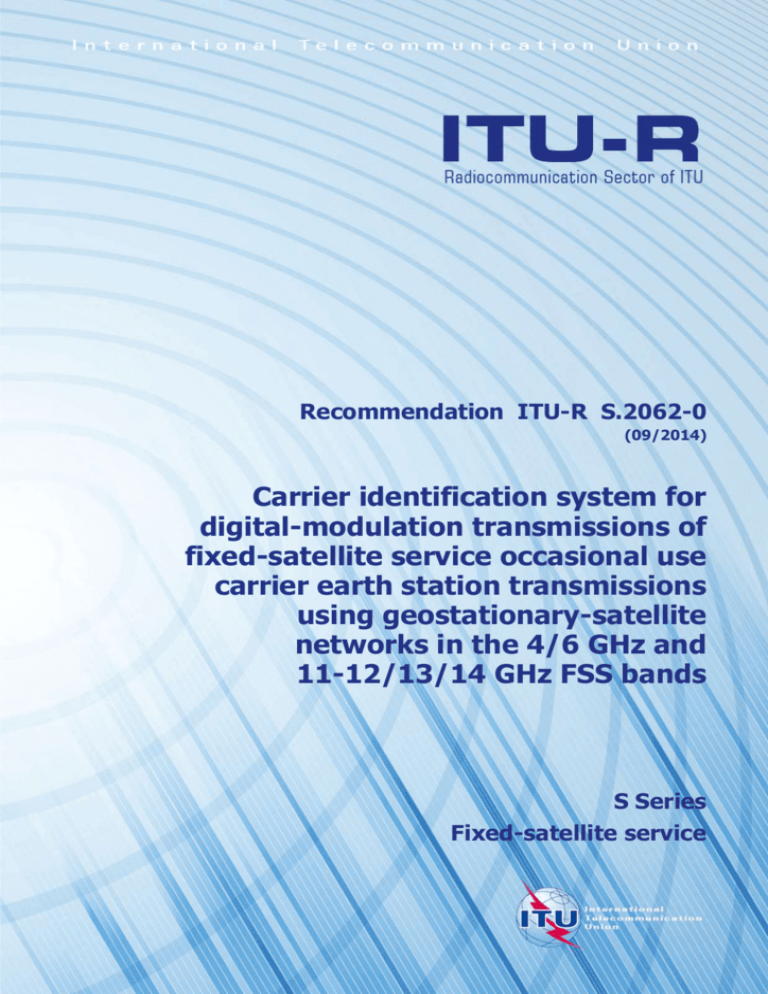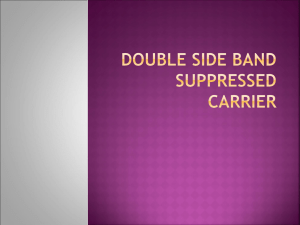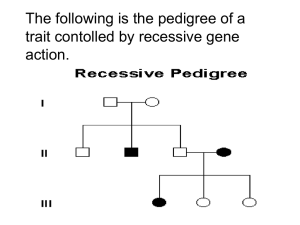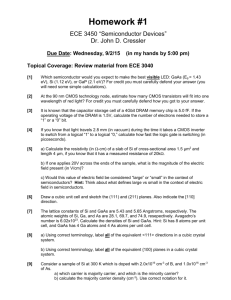
Recommendation ITU-R S.2062-0
(09/2014)
Carrier identification system for
digital-modulation transmissions of
fixed-satellite service occasional use
carrier earth station transmissions
using geostationary-satellite
networks in the 4/6 GHz and
11-12/13/14 GHz FSS bands
S Series
Fixed-satellite service
ii
Rec. ITU-R S.2062-0
Foreword
The role of the Radiocommunication Sector is to ensure the rational, equitable, efficient and economical use of the
radio-frequency spectrum by all radiocommunication services, including satellite services, and carry out studies without
limit of frequency range on the basis of which Recommendations are adopted.
The regulatory and policy functions of the Radiocommunication Sector are performed by World and Regional
Radiocommunication Conferences and Radiocommunication Assemblies supported by Study Groups.
Policy on Intellectual Property Right (IPR)
ITU-R policy on IPR is described in the Common Patent Policy for ITU-T/ITU-R/ISO/IEC referenced in Annex 1 of
Resolution ITU-R 1. Forms to be used for the submission of patent statements and licensing declarations by patent
holders are available from http://www.itu.int/ITU-R/go/patents/en where the Guidelines for Implementation of the
Common Patent Policy for ITU-T/ITU-R/ISO/IEC and the ITU-R patent information database can also be found.
Series of ITU-R Recommendations
(Also available online at http://www.itu.int/publ/R-REC/en)
Series
BO
BR
BS
BT
F
M
P
RA
RS
S
SA
SF
SM
SNG
TF
V
Title
Satellite delivery
Recording for production, archival and play-out; film for television
Broadcasting service (sound)
Broadcasting service (television)
Fixed service
Mobile, radiodetermination, amateur and related satellite services
Radiowave propagation
Radio astronomy
Remote sensing systems
Fixed-satellite service
Space applications and meteorology
Frequency sharing and coordination between fixed-satellite and fixed service systems
Spectrum management
Satellite news gathering
Time signals and frequency standards emissions
Vocabulary and related subjects
Note: This ITU-R Recommendation was approved in English under the procedure detailed in Resolution ITU-R 1.
Electronic Publication
Geneva, 2014
ITU 2014
All rights reserved. No part of this publication may be reproduced, by any means whatsoever, without written permission of ITU.
Rec. ITU-R S.2062-0
1
RECOMMENDATION ITU-R S.2062-0
Carrier identification system for digital-modulation transmissions of
fixed-satellite service occasional use carrier earth station transmissions
using geostationary-satellite networks in the 4/6 GHz
and 11-12/13/14 GHz FSS bands
(Question ITU-R 271/4)
(2014)
Scope
This Recommendation provides possible methods about a carrier identification system for digitalmodulations of fixed-satellite service (FSS) Occasional use (OU) carrier earth station transmissions from
a fixed point to GSO space stations in the 4/6 GHz and 11-12/13/14 GHz FSS bands to facilitate the
identification of the source of, and eliminate, unacceptable interference.
Keywords
Carrier-ID; occasional use; FSS.
Abbreviations/Glossary
ASCII
American Standard Code for Information Interchange
BCH
Bose, Ray-Chaudhuri, Hocquenghem code
BPSK
Binary phase shift keying
Carrier-ID
Carrier identification system
CRC
Cyclic redundancy check
FEC
Forward error correction
IRD
Integrated receiver/decoder
MPEG
Moving Picture Expert Group
NIT
Network information table
OU
Occasional use
PID
Packet identifier
PSD
Power spectral density
STB
Set top box
TDMA
Time division multiple access
TS
Transport stream
2
Rec. ITU-R S.2062-0
Related ITU Recommendation
Recommendation ITU-R S.2049
Access procedures for fixed-satellite service occasional use,
transmissions to geostationary-satellite orbit space stations, in the
4/6 GHz and 11-12/13/14 GHz FSS bands
The ITU Radiocommunication Assembly,
considering
a)
that occasional use (OU) transmissions in the 4/6 GHz and 11-12/13/14 GHz FSS bands
often require changes in earth station antenna pointing, frequency, power level, polarization sense,
carrier bandwidth and modulation technique;
b)
that the wide use of OU transmitting earth stations, and their recurring changes in link
parameters, has resulted in frequent cases of unintentional interference to other satellite users;
c)
that this interference is most frequently caused by operator error and/or equipment failure;
d)
that interference may inhibit the reception of time-sensitive information;
e)
that it is difficult to precisely identify the source of such interference;
f)
that there has been no internationally-recognized technical method for identifying the
source of such interference;
g)
that technologies exist which will permit the identification of interference sources in a short
period of time;
h)
that the ability to rapidly identify the source is essential to cease unacceptable interference,
recommends
1
that OU FSS earth station transmissions in the bands listed in considering a) could use
a carrier identification system (Carrier-ID) to allow the timely detection of interference sources and
to cease unacceptable interference;
2
that the carrier identification implementation described in Annex 1 should be considered
in the implementation of recommends 1.
Annex 1
Methods to identify interference from fixed-satellite service occasional use earth
station transmissions using geostationary-satellite networks
in the 4/6 GHz and 11-12/13/14 GHz FSS bands
1
Introduction
In general, when interference is observed at a service provider’s earth station, the provider tries to
investigate the causes of interference by utilizing a spectrum analyser or similar measurement tools
at each monitoring point for a certain period. Once the service provider finds a suspicious carrier,
it consults with its satellite operator to assist with rectifying the problem. If the satellite operator
cannot identify the possible source of interference, the resulting long-term interference may
Rec. ITU-R S.2062-0
3
adversely affect existing services. Therefore, a carrier identification system (Carrier-ID) would be
beneficial in sparing existing services from long-term interference.
It is noted that Occasional use (OU) refers to satellite ground facilities and satellite transponder
bandwidth, purchased or utilized on a temporary or as-needed basis. Typically these resources are
offered in segments starting at 5 minutes, progressing up to multiple hours, days, weeks or even
months, and used for non-fulltime and/or short-duration transmissions. Transmissions within a GSO
FSS network where earth stations are under the automated control of a central station, such as
transmissions within a centrally-managed VSAT network, are not considered OU transmissions for
the purposes of this Recommendation.
2
Overview of carrier identifier (Carrier-ID)
There are two methods of transmitting a Carrier-ID with the original carrier while having minimal
impact on the desired data. Possible methods are as follows.
2.1
–
Method A: Network Information Table (NIT) Carrier-ID
insert the Carrier-ID as a Network Information Table (NIT) frame in the original Transport
stream (TS) packets of the MPEG Stream.
TS packets of MPEG streams consist of a 4 bytes header and 184 bytes payload, and in the header,
there is a Packet identifier (PID) which indicates the contents in the payload of TS packets defined
as in Fig. 1. This PID value needs to be set as 0x0010 to indicate a payload of a TS packet as a NIT.
With regard to the NIT itself, the DVB specification allows this table to be retransmitted between
25 ms and 10 s.
FIGURE 1
Frame structure of TS packets
188 bytes
Transport
stream
packets
Sync
byte
Transport
error
indicator
Header
Payload
unit start
indicator
Payload
Transport
priority
Header
PID
Transport
scrambling
control
Payload
Adaptation
field
control
Continuity
counter
Adaptation
field
S. 2062-01
In the payload of TS packets, the NIT contains the manufacturer’s name and the unique unit serial
number to provide unique identifier for traceability. In addition to that, any other optional data such
as phone number, location information, etc. shown in Table 1, could be included in the payload of
TS packets depending on the requests from the satellite operators. These strings are fixed length,
and shall be separated by a comma ‘,’. If there are padding characters in each of strings, an
underscore “_” will be used to make complete the string. With these rules, total character counts for
Carrier ID in the NIT frame shall be 80. When the TS packets containing NIT are suffering from
interference or if the TS packets are encrypted, the NIT is unable to be read by a decoder.
Some manufacturers of encoders enable NIT Carrier-ID in equipment already available or through
a firmware update.
4
Rec. ITU-R S.2062-0
TABLE 1
An example content ID and content information
2.2
–
Carrier identifier format
2 character string numeric only
Encoder manufacturer
5 character string
Encoder serial number
12 character string
Carrier identifier
5 character string
Telephone number
17 character string numeric only
Longitude
17 character string numeric only
Latitude
8 character string
User information
15 character string
Method B: Spread Spectrum Carrier-ID
Carrier-ID with specific carrier information is embedded within a low rate spread spectrum
carrier which is sent overlaying the original carrier without adding appreciable noise to the
original carrier.
By contrast to the NIT method, in the Spread Spectrum method, the Carrier-ID information is more
likely to be successfully extracted even in the presence of severe interference. Spread Spectrum
Carrier-ID is available on existing modulators from some manufactures and is available as a
firmware update on a few not-too-old modulators. Modulators with Spread Spectrum Carrier-ID are
marked with a DVB-CID symbol. An external Carrier-ID encoder can also be purchased to add
Carrier-ID to existing modulated carriers. Dedicated equipment is needed to detect and decode the
Spread Spectrum Carrier-ID on the receiving side.
Figure 2 shows an example Carrier-ID spread block diagram. After the Format Message is set
completely, this message is encoded by the CRC encoder, and also encoded by the BCH FEC
encoder, and then a Carrier-ID frame is constructed with adding the unique word bits. This CarrierID will be scrambled and spread using the 4 096 chips/bit afterword.
FIGURE 2
An example Carrier-ID spread block diagram
Format
message
(2*61 bits)
Add UW
(22 bits)
and repeat
4 times
(4*244 bits)
Add
CRC8
(2*69 bits)
BCH FEC
encode
(2*111 bits)
Scramble
Message
frame
buffer
Differential
encoder
Spread by
4 096
S. 2062-0 2
Following this Carrier-ID spread block diagram, the Carrier-ID Frame is spread as indicated in
Fig. 3. At first, a Format Message is created by operators via the front panel or remote user
interface, and this message includes a “Global Unique ID_High and Low” identifier, Content ID
Rec. ITU-R S.2062-0
5
and Content Information. As for Global Unique IDs, Global Unique ID_High indicates Manufacture
ID, and Global Unique ID_Low indicates Extended ID.
FIGURE 3
An example scheme of the Carrier-ID frame
Add UW 244 bits
BCH FEC encode 111 bits
BCH FEC encode 111 bits
Add CRC 69 bits
Add CRC 69 bits
Format message 61 bits
Unique
word
22 bits
Message
frame
buffer
Global
unique
ID high
32 bits
Content ID1
5 bits
244 bits
Format message 61 bits
Content
info1
24 bits
FEC
encode1
42 bits
CRC1
8 bits
244 bits
Global
unique
ID low
32 bits
Content ID2
5 bits
Content
info2
24 bits
244 bits
CRC2
8 bits
FEC
encode2
42 bits
244 bits
Differential encoding
976 bits
Spread by 4 096 chips
976 bits * 4 096 chips
S. 2062-0 3
Table 2 shows example Content ID and Content information which help to identify the location of
the carrier source. Operators should enter the information of the source into each of information
field, as required by their satellite operator.
TABLE 2
Example content ID and content information
Content ID
Information field content
0
Carrier ID revision code
1
Latitude
2
Longitude
3-5
Telephone No.
6-12
User Data (Message by ASCII
code)
13-31
Undefined
After spreading, each chip of the sequence of the Carrier-ID frame shall be mapped into a BPSK
constellation to generate a modulation symbol. This BPSK mapping signal shall be transmitted with
lower power spectral density (PSD) than the noise floor of the original carrier by adjusting the
transmitting gain not to affect the throughput over the satellite.
Therefore, Table 3 and Fig. 4 show the example definition of the relative power spectral density
against the original carrier in detail.
6
Rec. ITU-R S.2062-0
TABLE 3
Example relative power spectral density levels for the original carrier
Carrier-ID’s chip rate
(kHz)
Host carrier symbol
rates (S) range
(kBaud)
Original carrier PSD level
relative to host carrier
centre PSD
(dB)
112
128 ≤ S < 256
–27.5
112
256 ≤ S < 512
–27.5
224
512 ≤ S < 1024
–27.5
224
1 024 ≤ S < 2 048
–27.5
224
2 048 ≤ S < 4 096
–24.5
224
4 096 ≤ S < 8 192
–21.5
224
8 192 ≤ S < 16 384
–18.5
224
16 384 ≤ S
–17.5
FIGURE 4
Original carrier PSD level relative to host carrier centre PSD
Center frequency
Original carrier
Typically -27.5 dB
Spread spectrum
carrier-ID
Noise
floor
Chip rate 112-224 kHz
S.2062 -04
2.3
Comparative specifications between NIT Carrier-ID and Spread Spectrum CarrierID
Table 4 shows the comparative specification between NIT Carrier-ID and Spread Spectrum
Carrier-ID systems with advantages and disadvantages of each system.
Rec. ITU-R S.2062-0
7
TABLE 4
Comparative specifications
NIT Carrier-ID
Spread Spectrum Carrier-ID
Transponder and Carrier
Compatibility
Requires MPEG-TS (Video)
– Broadcast Contribution
– Broadcast Distribution
Agnostic to traffic carrier or
transport mechanism
– Video and Data transport
focused
Changes to original carrier
Yes (add NIT table)
No (spread spectrum carrier is
overlay to the original carrier)
Robustness
Low (Carrier-ID not recoverable
if the original carrier is down)
Higher (Carrier-ID can be
decoded even if the original
carrier is down)
Injection point
Modulator or Encoder
Modulator
Carrier ID decode speed
Under 10 seconds
15 seconds to over 1 minute*
Ease of deployment
Modulator: Software upgrade
only
Decoder: existing IRD and STB
Modulator: DVB-CID Compliant
Modulators or additional
dedicated equipment
Decoder: additional dedicated
equipment
*
3
Decoding speed of the Spread Spectrum Carrier-ID depends on the relative power of the interfering
carrier and the desired carrier, the accuracy of the estimate of the symbol rate of the interfering carrier,
and the accuracy of the estimate of the centre frequency of the interfering carrier.
Carrier-ID identifying configuration
As mentioned above, in general, NIT does not need special equipment to insert and detect the
Carrier-ID, i.e. just updating the software of the modulator or encoder, while the Spread Spectrum
method requires dedicated equipment to insert the Carrier-ID for older modulators that are not
DVB-CID compliant.
The receiving devices also need special function of receiving and identifying or decoding the
Carrier-ID. However, the function of decoding the ID need not to be installed in all receivers,
but a dedicated receiver, which may be owned and operated by the satellite operator.
The satellite operator also needs to control and maintain the Carrier-ID in an integrated fashion,
i.e. their customer database, in order to resolve an ID to a transmitting earth station.
4
Summary
Carrier-ID may be used to facilitate the rapid identification of an interference source and reduce
the time required to clear the interference that occurs unintentionally.








